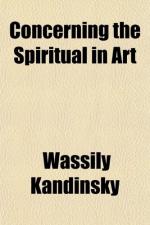One of the first steps in the turning away from material objects into the realm of the abstract was, to use the technical artistic term, the rejection of the third dimension, that is to say, the attempt to keep a picture on a single plane. Modelling was abandoned. In this way the material object was made more abstract and an important step forward was achieved—this step forward has, however, had the effect of limiting the possibilities of painting to one definite piece of canvas, and this limitation has not only introduced a very material element into painting, but has seriously lessened its possibilities.
Any attempt to free painting from this material limitation together with the striving after a new form of composition must concern itself first of all with the destruction of this theory of one single surface—attempts must be made to bring the picture on to some ideal plane which shall be expressed in terms of the material plane of the canvas. [Footnote: Compare the article by Le Fauconnier in the catalogue of the second exhibition of the Neue Kunstlervereinigung, Munich, 1910-11.] There has arisen out of the composition in flat triangles a composition with plastic three-dimensional triangles, that is to say with pyramids; and that is Cubism. But there has arisen here also the tendency to inertia, to a concentration on this form for its own sake, and consequently once more to an impoverishment of possibility. But that is the unavoidable result of the external application of an inner principle.
A further point of great importance must not be forgotten. There are other means of using the material plane as a space of three dimensions in order to create an ideal plane. The thinness or thickness of a line, the placing of the form on the surface, the overlaying of one form on another may be quoted as examples of artistic means that may be employed. Similar possibilities are offered by colour which, when rightly used, can advance or retreat, and can make of the picture a living thing, and so achieve an artistic expansion of space. The combination of both means of extension in harmony or concord is one of the richest and most powerful elements in purely artistic composition.
VII. THEORY
From the nature of modern harmony, it results that never has there been a time when it was more difficult than it is today to formulate a complete theory, [Footnote: Attempts have been made. Once more emphasis must be laid on the parallel with music. For example, cf. “Tendances Nouvelles,” No. 35, Henri Ravel: “The laws of harmony are the same for painting and music.”] or to lay down a firm artistic basis. All attempts to do so would have one result, namely, that already cited in the case of Leonardo and his system of little spoons. It would, however, be precipitate to say that there are no basic principles nor firm rules in painting, or that a search for them leads inevitably to academism. Even music has a grammar, which, although modified from time to time, is of continual help and value as a kind of dictionary.




